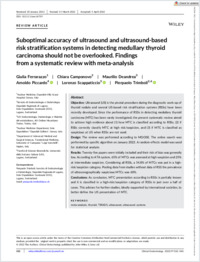Suboptimal accuracy of ultrasound and ultrasound-based risk stratification systems in detecting medullary thyroid carcinoma should not be overlooked : findings from a systematic review with meta-analysis
- Ferrarazzo, Giulia Nuclear Medicine, Ospedale Villa Scassi Hospital, Genoa, Italy
- Camponovo, Chiara Servizio di Endocrinologia e Diabetologia, Ospedale Regionale di Lugano, Ente Ospedaliero Cantonale (EOC), Lugano, Switzerland
- Deandrea, Maurilio ORCID UO Endocrinologia, Diabetologia e Malattie del metabolismo, AO Ordine Mauriziano Torino, Torino, Italy
- Piccardo, Arnoldo ORCID Nuclear Medicine Department, Ente Ospedaliero “Ospedali Galliera”, Genoa, Italy
- Scappaticcio, Lorenzo ORCID Department of Advanced Medical and Surgical Sciences, Translational Medicine, University of Campania “Luigi Vanvitelli”, Naples, Italy
- Trimboli, Pierpaolo ORCID Servizio di Endocrinologia e Diabetologia, Ospedale Regionale di Lugano, Ente Ospedaliero Cantonale (EOC), Lugano, Switzerland - Faculty of Biomedical Sciences, Università della Svizzera italiana, Switzerland
- 2022
Published in:
- Clinical endocrinology. - 2022, vol. 97, no. 5, p. 532-540
English
Objective: Ultrasound (US) is the pivotal procedure during the diagnostic work-up of thyroid nodule and several US-based risk stratification systems (RSSs) have been recently developed. Since the performance of RSSs in detecting medullary thyroid carcinoma (MTC) has been rarely investigated, the present systematic review aimed to achieve high evidence about (1) how MTC is classified according to RSSs; (2) if RSSs correctly classify MTC at high risk/suspicion, and (3) if MTC is classified as suspicious at US when RSSs are not used. Design: The review was performed according to MOOSE. The online search was performed by specific algorithm on January 2022. A random-effects model was used for statistical analysis. Results: Twenty-five papers were initially included and their risk of bias was generally low. According to ATA system, 65% of MTCs was assessed at high suspicion and 25% at intermediate suspicion. Considering all RSSs, a 54.8% of MTCs was put in a high-risk/suspicion category. Pooling data from studies without data of RSS the prevalence of ultrasonographically suspicious MTCs was 60%. Conclusions: As conclusion, MTC presentation according to RSSs is partially known and it is classified in a high-risk/suspicion category of RSSs in just over a half of cases. This advises for further studies, ideally supported by international societies, to better define the US presentation of MTC.
- Collections
- Language
-
- English
- Classification
- Medicine
- License
- Open access status
- hybrid
- Identifiers
-
- DOI 10.1111/cen.14739
- ARK ark:/12658/srd1326715
- Persistent URL
- https://n2t.net/ark:/12658/srd1326715
Statistics
Document views: 87
File downloads:
- Trimboli_2022_Wiley_ClinEndocr: 204
